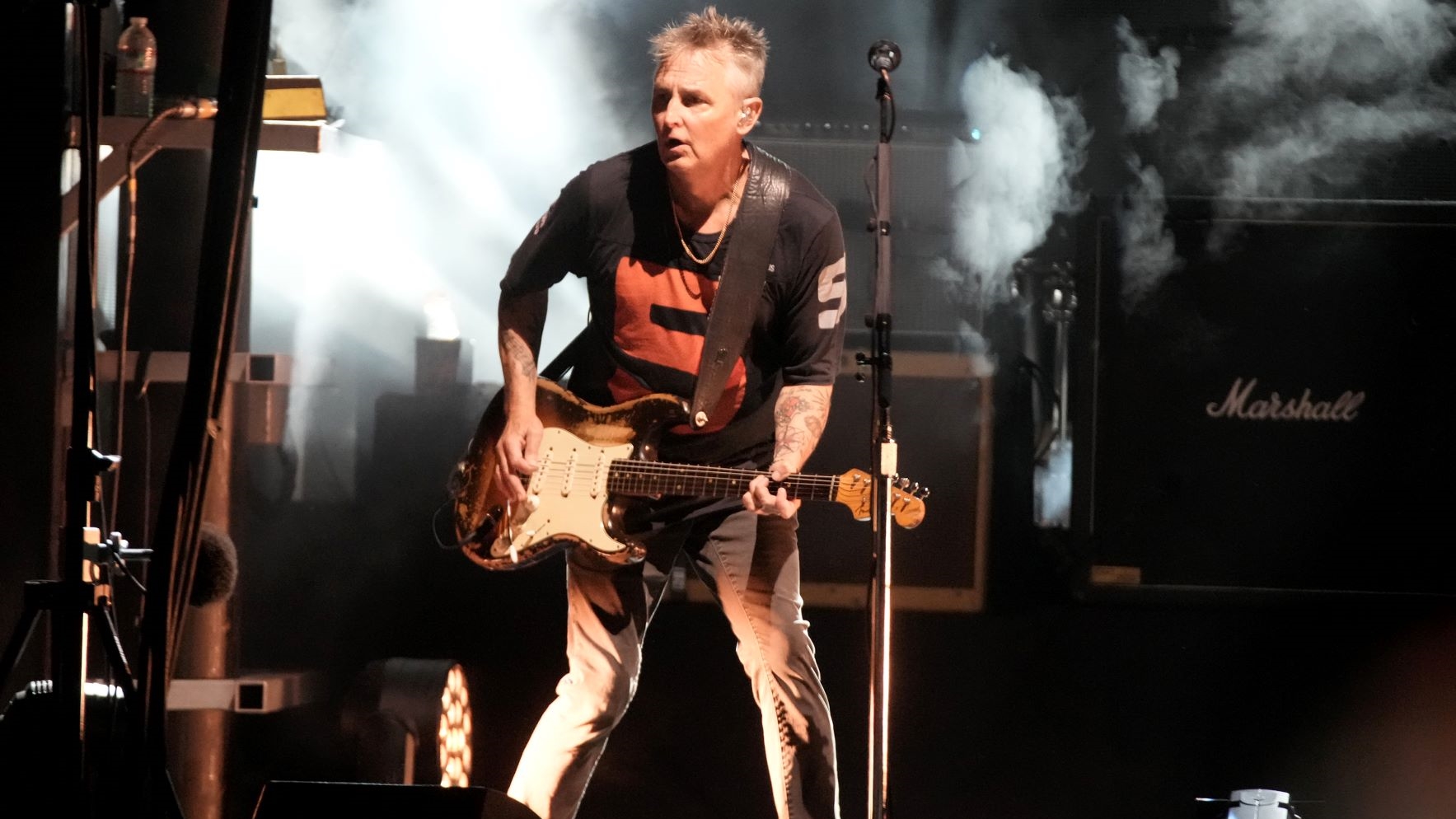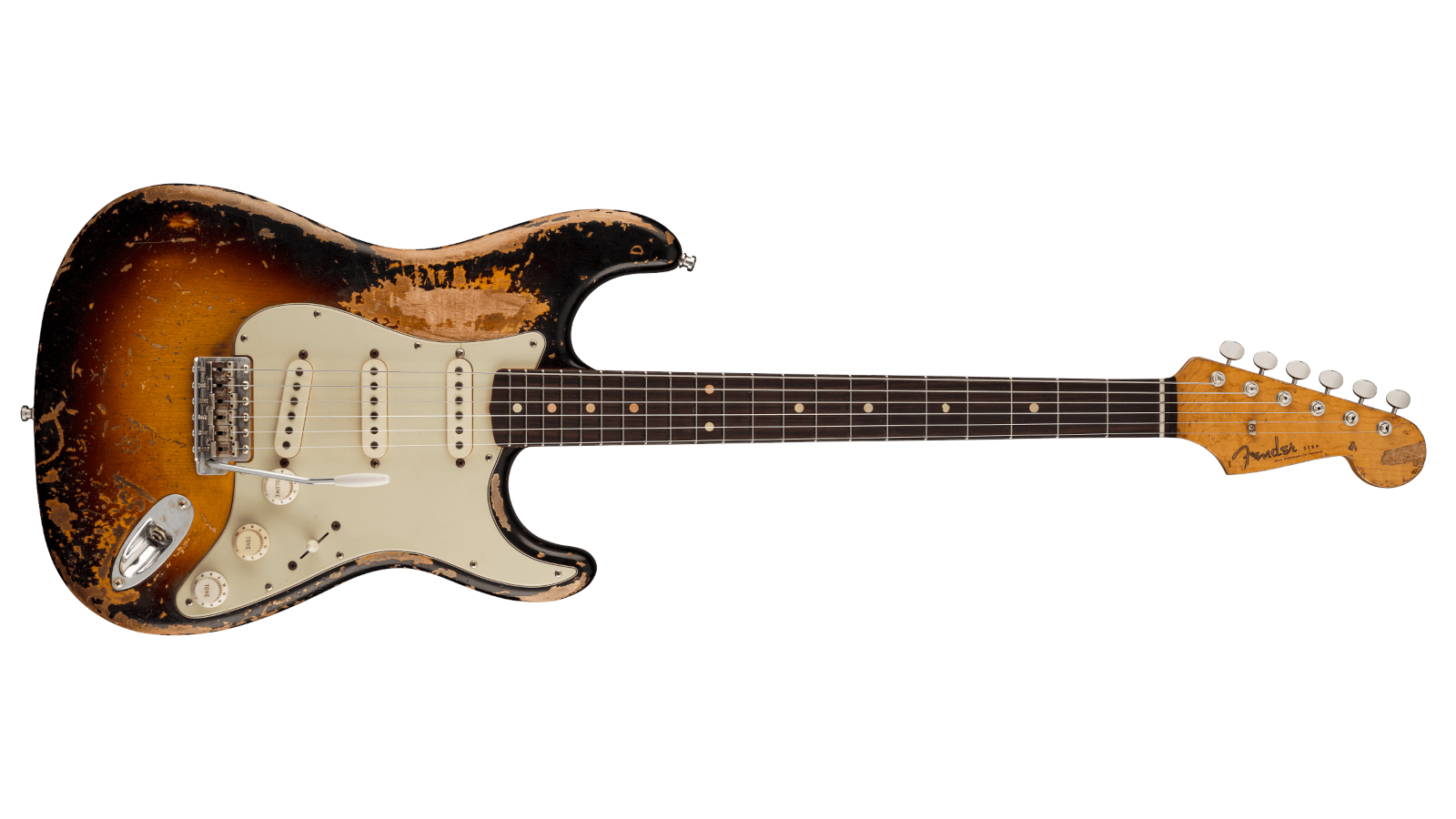Mike McCready Names His Top Five Career-Defining Tracks
From Temple of the Dog to Pearl Jam, these are the cuts the guitarist singles out from his long, successful run.

Mike McCready’s classic rock-and blues-influenced soloing has been part of Pearl Jam’s signature sound since they formed under the name Mookie Blaylock in Seattle, in 1990.
Signing to Epic Records the following year, they changed their name and released their debut album, Ten, a breakthough that generated three hit singles – “Alive,” “Even Flow” and “Jeremy” – and established the band as a major force in the ’90s music scene.
Pearl Jam developed a sound contemporaneous with the burgeoning grunge movement, yet they were unafraid to reference elements of classic rock in their arrangements.
Playing alongside rhythm and co-lead guitarist Stone Gossard, McCready brought elements of Hendrix, Stevie Ray Vaughan and David Gilmour without ever resorting to slavishly ripping off their licks.
Pearl Jam have always maintained a high degree of quality control over their music, releasing only 11 studio albums to date over a 30-year career.
The band’s latest full-length, 2020’s Gigaton, followed after a seven-year gap from the album before it, 2013’s Lightning Bolt.
According to McCready, that is not the intention for their next record.
“Assuming all goes according to plan, we’ll be touring the states and Europe in 2022, and then we should be looking at making an album after that,” he tells Guitar Player.
“So I don’t expect there to be anywhere near as long an interval before the next record comes out.”

Reflecting his love of Stevie Ray Vaughan, McCready bought what he thought was a 1959 Fender Strat in 1991.
“It was the first expensive guitar that I ever owned,” he explains. “It was kind of beat-up around the sides, but it’s gotten a lot worse since I bought it; I do love electric guitars that look beat up. I put a five-way switch in because it had the original three-way and I use all the switch positions on the Strat, so I really get the full mileage out of the sonic options.
“Fender wanted to make a custom model, replicating every detail on the guitar, so they took it away for a couple of days to measure and photograph everything. When they brought it back to me, they told me that it’s actually a ’60 Strat.
“I was totally shocked. I felt like I’d been living a lie for years.” He laughs. “I’ve got a ’59 tattoo, so I need to get a ‘plus one’ added to it.”
Notwithstanding the unexpected news regarding the guitar’s vintage, McCready was blown away by what the Custom Shop came up with.
“They did such a great job that I’ve actually confused the new model with the original at times,” he admits.
“I did wonder for a moment if my original might feel a little different once they’d taken it apart and reassembled it, but it was in the hands of master builders, so the mojo was still there when I got it back.
“I guess I’ve done maybe a thousand shows with it, so it’s a part of me. We’re working on a more affordable signature model now, because obviously this limited-run Custom Shop model is a relatively expensive guitar.”

McCready has performed with many acts over the years, including Temple of the Dog, featuring late Soundgarden vocalist Chris Cornell (1964-2017), and Mad Season, fronted by deceased Alice in Chains singer Layne Staley (1967-2002).
More than 30 years down the line, he is more enthusiastic and excited by music than ever before.
I’m always learning, working on improving my songwriting ability and staying in gratitude
Mike McCready
“Just as lockdown kicked in, we were all rehearsed and ready to go on tour,” he says. “I learned to use GarageBand, and since I had a lot of time on my hands, I got pretty good at using it and worked on a lot of song ideas. It helped me keep my sanity.
“I’m always learning, working on improving my songwriting ability and staying in gratitude. I try to keep learning new things all the time. It’s so great to have such a huge fanbase that still wants to see us. That still blows me away and keeps everything exciting year after year.”
1) Temple of the Dog | “Reach Down” from ‘Temple of the Dog' (1991)
“Temple of the Dog was the first legitimate album that I played on. Chris Cornell wrote a demo for this song that was just spectacular. He played everything on it. I remember him saying, ‘Hey, let’s make the first song on the record an 11-minute song, just to piss off the record company!’ [laughs]
“He’d said, ‘We’ll need a long lead part on the song to stretch it out.’ I was very nervous; I wanted to make sure I wasn’t overplaying and that I was respecting the song. I did one lead and Chris said, ‘I think you can do better,’ and then he went out for a cigarette.
I’m still so grateful to Chris and the guys for giving me the opportunity there to really put my own mark on such a great song
Mike McCready
“I just really went for it on the next take. I pulled out all the tricks I’d learned up to that point from listening to Stevie Ray Vaughan and Jimi Hendrix, toggle-switch stuff – everything. I didn’t think about it though; I was just playing.
“For the last minute and a half of the solo, my headphones had fallen off, but I was so into it that I played on through. That’s the take on the record. Somehow, I really channeled something special.
“I think people weren’t really playing long solos so much at that time, and I’m still so grateful to Chris and the guys for giving me the opportunity there to really put my own mark on such a great song.”
2) Pearl Jam | “Present Tense” from ‘No Code’ (1996)
“I wrote this song at a time when I was trying to experiment and do different things. I just came in with that riff and started singing some lyrics, and the guys helped me arrange it.
“I like to have a lot of dynamics in my songs, and I felt that this was something that we could really build when we played it live. The intro was just me and Ed [Eddie Vedder], and hearing the crowd sing the lyrics back when we do that part live is immensely moving and satisfying.
The song is about keeping things in the present tense, not tripping out about the future too much
Mike McCready
“The song is about keeping things in the present tense, not tripping out about the future too much or worrying about the past. I love that idea. If I can stay in the present tense, my life is much better.
“This song is in D tuning, with the G tuned to F#. There’s a lot of space in the song. I think I’m using an MXR Phase 90 on the intro, and the track builds from there.
“Everybody in the band is aware of space and thinking about what not to put in the song. That’s a David Gilmour thing I picked up on. He uses space to let his solos breathe.”
3) Pearl Jam | “Given to Fly” from ‘Yield’ (1998)
“I recorded the Mad Season album, Above, with Layne Staley around the time that I wrote this song, in ’94. This track was a huge deal for me, because it was the first time I’d ever gotten sober, and making that Mad Season record gave me the confidence that I could really do this and write songs in a new frame of mind for Pearl Jam records as well.
“On the day I wrote it, it was snowing in Seattle. I was messing around with different tunings, and I had this euphoric feeling, like, ‘Wow, I can write those kind of songs now.’ I felt like I had a new confidence.
“Prior to then, the fact that there were so many great writers in Pearl Jam made me feel less confident in putting my songs forward. But with ‘Given to Fly,’ I felt that I could really relate to the lyrics that Eddie came up with. It was a turning point for me, and it’s one my favorite songs of all the ones I’ve ever written.
This track was a huge deal for me, because it was the first time I’d ever gotten sober
Mike McCready
“I tuned my ’60 Strat to open D, without detuning the G string to F#. When you change tunings, it forces you to play a different way. Recently, I’ve been doing a lot of things in standard tunings but using capos to change the feel of what I’m playing.
“I like to be pushed, though, and a different tuning will really do that. I like to make a mistake and learn from it, and different tunings help with that. They break you out of all the habits that you gravitate toward subconsciously in standard tuning.
“I think I recorded this with a Fender Bassman into a Marshall JCM800 and a 4x12 with four 25-watt speakers and my MXR Phase 90.
“Some people have said it sounds a little like ‘Going to California.’ It never even occurred to me at the time. I’ll certainly cop to ripping off some Zep in my songs at times, but that wasn’t the case on this one. [laughs]
“Robert Plant came to one of our shows in Sweden, and he jokingly gave me some shit about it. It was glorious. Eddie even introduced the song as ‘Given to California’ on that date.” [laughs]
4) Pearl Jam | “Inside Job” from ‘Pearl Jam’ (2006)
“This was one of the first times that I’d written lyrics as well as all the music to a song. We were trying to get it ready for the record and we were running out of time. It was getting down to the wire and Eddie didn’t have any lyrics.
“We were on tour in Mexico, and I remember thinking that if I don’t come up with some lyrics for this song now, it’s not gonna make the cut. I just sat down and wrote what I was feeling, in terms of how it’s an inside job for me to take care of myself, my demons or whatever, and find a spiritual solution, so that was the angle I was looking at.
“I remember when I’d completed the song and took it to play for Eddie, I was super nervous: ‘Okay, I’m going to sing for Ed’. [laughs] He was very gracious about it and he liked the lyrics.
I don’t generally write solos out, but I did for this one
Mike McCready
“When we got back from that tour and Ed put his vocals on it, it sounded amazing. I really wanted to write an epic piece of music, and I think the band helped me to pull that off. I played the acoustic intro underneath the strange, dissonant notes that Stone put over the top, which made it sound darker and cooler.
“Live, I go totally Jimmy Page and use my double-neck SG [Gibson EDS-1275] for this. I don’t generally write solos out, but I did for this one. I wanted to put something down that would be a solo that I’d always want to reproduce when we played the song live.”
5) Pearl Jam | “Sirens” from ‘Lightning Bolt’ (2013)
“I’m so happy with the way the music for this track turned out, and Ed’s lyrics are really beautiful. We recorded this in L.A., and I worked out a delayed lead on it. I wanted to sound like a siren passing by you.
“It was another lead part that I consciously wrote to be a permanent fixture in the song. I was trying to channel some David Gilmour. I’d seen The Wall tour around this time, which was the most incredible show I’d ever seen.
“I love Gilmour; he is the master of delay, subtlety, underplaying and knowing when to hit exactly the right note. His solos are songs within a song. I don’t know if he works them out or not. We cover ‘Comfortably Numb’, and I have to do that solo exactly note for note. You can’t improvise on it; it just doesn’t sound right.
The problem with repeated takes is that I think about it too much and start trying to fit in parts that I liked
Mike McCready
“Stone and I are always discussing how perfect Gilmour’s solos are. I’d say about 10 percent of my solos are worked out, and the rest are off the cuff.
“Initially it came out of laziness and not wanting to re-learn my solos. After a while I found that my first two or three leads are the best ones. Sometimes I’ll do a comp.
“The problem with repeated takes is that I think about it too much and start trying to fit in parts that I liked, but the spontaneity will have gone and it never has the same spark if I do multiple takes. After three takes I’m usually not feeling it.”
Browse the Pearl Jam catalog here.
Get The Pick Newsletter
All the latest guitar news, interviews, lessons, reviews, deals and more, direct to your inbox!
Mark is a freelance writer with particular expertise in the fields of ‘70s glam, punk, rockabilly and classic ‘50s rock and roll. He sings and plays guitar in his own musical project, Star Studded Sham, which has been described as sounding like the hits of T. Rex and Slade as played by Johnny Thunders. He had several indie hits with his band, Private Sector and has worked with a host of UK punk luminaries. Mark also presents themed radio shows for Generating Steam Heat. He has just completed his first novel, The Bulletproof Truth, and is currently working on the sequel.
"When they left town, I went to the airport and got to meet Ritchie, and he thanked me for covering for him." Christopher Cross recalls filling in for a sick Ritchie Blackmore on Deep Purple's first-ever show in the U.S.
"It’s as if all of Jeff Beck’s genius is right here on one album. There’s a taste of everything.” Joe Perry riffs on Beck, the Yardbirds and "The 10 Records That Changed My Life"











